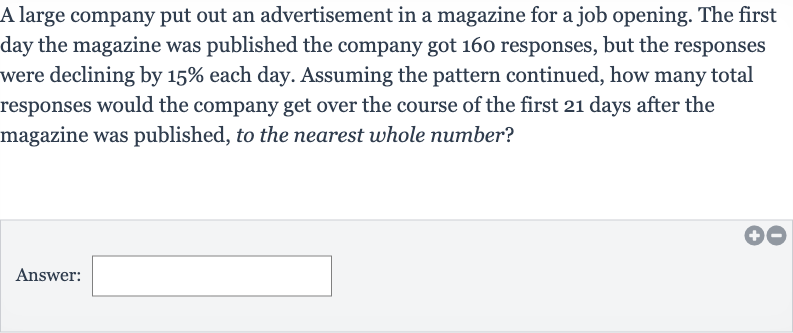AI tutor
Welcome to Bytelearn!
Let’s check out your problem:

A large company put out an advertisement in a magazine for a job opening. The first day the magazine was published the company got responses, but the responses were declining by each day. Assuming the pattern continued, how many total responses would the company get over the course of the first days after the magazine was published, to the nearest whole number?Answer:
Full solution
Q. A large company put out an advertisement in a magazine for a job opening. The first day the magazine was published the company got responses, but the responses were declining by each day. Assuming the pattern continued, how many total responses would the company get over the course of the first days after the magazine was published, to the nearest whole number?Answer:
- Identify Initial Data: Identify the initial number of responses and the daily decline rate.Initial responses on the first day: Daily decline rate: We need to calculate the total number of responses over days, considering a decline each day.
- Calculate Daily Responses: Calculate the number of responses for each day using the formula for a geometric sequence.The number of responses on the th day can be calculated using the formula:Where decline rate is ( as a decimal).
- Calculate Total Responses: Calculate the total number of responses over days.We will sum up the responses for each day using the formula from Step .Total responses We will use a loop or a summation formula to calculate this total.
- Perform Daily Calculations: Perform the calculations for each day and sum them up.Let's start by calculating the first few terms to ensure our formula is correct.Responses = Responses = Responses = ...We will continue this process until we reach day .
- Use Calculator for Sum: Use a calculator or a software tool to sum the geometric series.Since manually calculating each term and summing them up is time-consuming and prone to error, we will use a calculator or software to find the sum of the geometric series from day to day .
- Calculate Geometric Series Sum: Calculate the sum of the geometric series.The sum of a geometric series can be calculated using the formula:Sum = Where:a = first term of the series ( responses)r = common ratio (, since the decline is 15\%))\(\newlinen = number of terms (\$21\) days)\(\newline\)Sum = \(160 \times (1 - 0.85^{21}) / (1 - 0.85)\)
- Evaluate Total Responses: Evaluate the sum to the nearest whole number.\(\newline\)Using the formula from Step \(6\), we calculate the sum.\(\newline\)Sum \(\approx 160 \times (1 - 0.85^{21}) / (1 - 0.85)\)\(\newline\)Sum \(\approx 160 \times (1 - 0.08589) / 0.15\)\(\newline\)Sum \(\approx 160 \times 0.91411 / 0.15\)\(\newline\)Sum \(\approx 975.05\)\(\newline\)Rounded to the nearest whole number, the total number of responses is approximately \(975\).
More problems from Find probabilities using the binomial distribution
QuestionGet tutor help
QuestionGet tutor help
QuestionGet tutor help
QuestionGet tutor help
QuestionGet tutor help
QuestionGet tutor help
QuestionGet tutor help
QuestionGet tutor help
QuestionGet tutor help
QuestionGet tutor help
